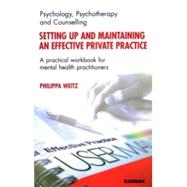
Note: Supplemental materials are not guaranteed with Rental or Used book purchases.
Purchase Benefits
Looking to rent a book? Rent Setting Up and Maintaining an Effective Private Practice [ISBN: 9781855754256] for the semester, quarter, and short term or search our site for other textbooks by Weitz, Phillipa. Renting a textbook can save you up to 90% from the cost of buying.
| ACKNOWLEDGEMENTS | x | ||||
| INTRODUCTION | xi | ||||
| CHECKING YOUR MOTIVATION FOR SETTING UP A PRIVATE PRACTICE | xvi | ||||
| SOME INITIAL WORDS OF ADVICE | xix | ||||
| HOW TO USE THIS BOOK | xxi | ||||
| CHAPTER ONE Marketing: Getting your first clients—telling the world about your business | 1 | (27) | |||
|
1 | (7) | |||
|
1 | (1) | |||
|
2 | (1) | |||
|
3 | (1) | |||
|
4 | (2) | |||
|
6 | (2) | |||
|
8 | (1) | |||
|
8 | (6) | |||
|
9 | (2) | |||
|
11 | (1) | |||
|
12 | (2) | |||
|
14 | (13) | |||
|
14 | (1) | |||
|
14 | (2) | |||
|
16 | (1) | |||
|
17 | (1) | |||
|
18 | (2) | |||
|
20 | (5) | |||
|
20 | (1) | |||
|
21 | (2) | |||
|
23 | (1) | |||
|
24 | (1) | |||
|
25 | (2) | |||
|
27 | (1) | |||
| CHAPTER TWO Setting up the structure of the business | 28 | (31) | |||
|
28 | (7) | |||
|
29 | (1) | |||
|
29 | (1) | |||
|
30 | (2) | |||
|
32 | (1) | |||
|
33 | (2) | |||
|
35 | (3) | |||
|
35 | (1) | |||
|
36 | (1) | |||
|
36 | (2) | |||
|
36 | (1) | |||
|
36 | (1) | |||
|
37 | (1) | |||
|
38 | (5) | |||
|
38 | (1) | |||
|
38 | (1) | |||
|
39 | (2) | |||
|
41 | (2) | |||
|
43 | (15) | |||
|
44 | (4) | |||
|
48 | (4) | |||
|
52 | (1) | |||
|
53 | (1) | |||
|
54 | (2) | |||
|
56 | (1) | |||
|
57 | (1) | |||
|
58 | (1) | |||
| CHAPTER THREE The practicalities of running the business | 59 | (24) | |||
|
59 | (10) | |||
|
59 | (1) | |||
|
60 | (1) | |||
|
61 | (1) | |||
|
62 | (1) | |||
|
63 | (4) | |||
|
63 | (3) | |||
|
63 | (2) | |||
|
65 | (1) | |||
|
66 | (1) | |||
|
67 | (2) | |||
|
69 | (5) | |||
|
69 | (1) | |||
|
70 | (1) | |||
|
71 | (1) | |||
|
72 | (1) | |||
|
73 | (1) | |||
|
73 | (1) | |||
|
74 | (1) | |||
|
74 | (8) | |||
|
74 | (3) | |||
|
77 | (14) | |||
|
78 | (2) | |||
|
80 | (1) | |||
|
81 | (1) | |||
|
81 | (1) | |||
|
82 | (1) | |||
|
82 | (1) | |||
| CHAPTER FOUR Specific issues for a counselling business | 83 | (17) | |||
|
83 | (2) | |||
|
85 | (1) | |||
|
86 | (1) | |||
|
87 | (1) | |||
|
88 | (1) | |||
|
88 | (1) | |||
|
89 | (2) | |||
|
91 | (2) | |||
|
91 | (1) | |||
|
92 | (1) | |||
|
93 | (1) | |||
|
94 | (1) | |||
|
94 | (1) | |||
|
95 | (1) | |||
|
96 | (1) | |||
|
96 | (1) | |||
|
97 | (1) | |||
|
97 | (1) | |||
|
97 | (2) | |||
|
99 | (1) | |||
|
99 | (1) | |||
| CHAPTER FIVE Working self-employed within the NHS | 100 | (3) | |||
|
102 | (1) | |||
| REFERENCES AND SUGGESTED READING | 103 | (2) | |||
| APPPENDICES | |||||
|
|||||
|
105 | (6) | |||
|
111 | (5) | |||
|
114 | (2) | |||
|
116 | (3) | |||
|
119 | (1) | |||
|
120 | (4) | |||
|
124 | (2) | |||
|
126 | (1) | |||
| INDEX | 127 |
The New copy of this book will include any supplemental materials advertised. Please check the title of the book to determine if it should include any access cards, study guides, lab manuals, CDs, etc.
The Used, Rental and eBook copies of this book are not guaranteed to include any supplemental materials. Typically, only the book itself is included. This is true even if the title states it includes any access cards, study guides, lab manuals, CDs, etc.